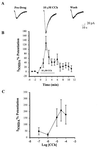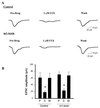Activation of the genetically defined m1 muscarinic receptor potentiates N-methyl-D-aspartate (NMDA) receptor currents in hippocampal pyramidal cells
- PMID: 9736760
- PMCID: PMC21666
- DOI: 10.1073/pnas.95.19.11465
Activation of the genetically defined m1 muscarinic receptor potentiates N-methyl-D-aspartate (NMDA) receptor currents in hippocampal pyramidal cells
Abstract
Evidence suggests that cholinergic input to the hippocampus plays an important role in learning and memory and that degeneration of cholinergic terminals in the hippocampus may contribute to the memory loss associated with Alzheimer's disease. One of the more prominent effects of cholinergic agonists on hippocampal physiology is the potentiation of N-methyl-D-aspartate (NMDA)-receptor currents by muscarinic agonists. Here, we employ traditional pharmacological reagents as well as m1-toxin, an m1 antagonist with unprecedented selectivity, to demonstrate that this potentiation of NMDA-receptor currents in hippocampal CA1 pyramidal cells is mediated by the genetically defined m1 muscarinic receptor. Furthermore, we demonstrate the colocalization of the m1 muscarinic receptor and the NR1a NMDA receptor subunit at the electron microscopic level, indicating a spatial relationship that would allow for physiological interactions between these two receptors. This work demonstrates that the m1-muscarinic receptor gene product modulates excitatory synaptic transmission, and it has important implications in the study of learning and memory as well as the design of drugs to treat neurodegenerative diseases such as Alzheimer's.
Figures





Similar articles
-
Nicotine and a positive allosteric modulator of m1 muscarinic receptor increase NMDA/AMPA ratio in the hippocampus and medial prefrontal cortex.Neuropharmacology. 2025 Jan 1;262:110213. doi: 10.1016/j.neuropharm.2024.110213. Epub 2024 Nov 8. Neuropharmacology. 2025. PMID: 39522675
-
Differential modulation by carbachol of four separate excitatory afferent systems to the rat subiculum in vitro.Hippocampus. 2004;14(8):986-99. doi: 10.1002/hipo.20016. Hippocampus. 2004. PMID: 15390173
-
Muscarinic-induced modulation of potassium conductances is unchanged in mouse hippocampal pyramidal cells that lack functional M1 receptors.Neurosci Lett. 2000 Jan 7;278(1-2):61-4. doi: 10.1016/s0304-3940(99)00914-3. Neurosci Lett. 2000. PMID: 10643801
-
The mechanisms shaping CA2 pyramidal neuron action potential bursting induced by muscarinic acetylcholine receptor activation.J Gen Physiol. 2020 Apr 6;152(4):e201912462. doi: 10.1085/jgp.201912462. J Gen Physiol. 2020. PMID: 32069351 Free PMC article.
-
Muscarinic Receptors, from Synaptic Plasticity to its Role in Network Activity.Neuroscience. 2021 Feb 21;456:60-70. doi: 10.1016/j.neuroscience.2020.04.005. Epub 2020 Apr 8. Neuroscience. 2021. PMID: 32278062 Review.
Cited by
-
Activation of group I metabotropic glutamate receptors produces a direct excitation and disinhibition of GABAergic projection neurons in the substantia nigra pars reticulata.J Neurosci. 2001 Sep 15;21(18):7001-12. doi: 10.1523/JNEUROSCI.21-18-07001.2001. J Neurosci. 2001. PMID: 11549710 Free PMC article.
-
Multiple Gq-coupled receptors converge on a common protein synthesis-dependent long-term depression that is affected in fragile X syndrome mental retardation.J Neurosci. 2007 Oct 24;27(43):11624-34. doi: 10.1523/JNEUROSCI.2266-07.2007. J Neurosci. 2007. PMID: 17959805 Free PMC article.
-
Neurotransmitter receptor expression and activity during neuronal differentiation of embryonal carcinoma and stem cells: from basic research towards clinical applications.Cell Prolif. 2006 Aug;39(4):281-300. doi: 10.1111/j.1365-2184.2006.00385.x. Cell Prolif. 2006. PMID: 16872363 Free PMC article. Review.
-
The Neuromodulatory Role of the Noradrenergic and Cholinergic Systems and Their Interplay in Cognitive Functions: A Focused Review.Brain Sci. 2022 Jul 7;12(7):890. doi: 10.3390/brainsci12070890. Brain Sci. 2022. PMID: 35884697 Free PMC article. Review.
-
Modulation of NMDA Receptors by G-protein-coupled receptors: Role in Synaptic Transmission, Plasticity and Beyond.Neuroscience. 2021 Feb 21;456:27-42. doi: 10.1016/j.neuroscience.2020.02.019. Epub 2020 Feb 24. Neuroscience. 2021. PMID: 32105741 Free PMC article. Review.
References
-
- Brown T H, Zador A M. In: The Synaptic Organization of the Brain. Shepherd G M, editor. New York: Oxford Univ. Press; 1990. pp. 346–388.
-
- Drachman D A, Leavitt J L. Arch Neurol. 1974;30:113–121. - PubMed
-
- Bartus R T, Dean D L I, Beer B, Lippa A S. Science. 1982;217:783–790. - PubMed
-
- Dekker A J A M, Connor D J, Thal L J. Neurosci Biobehav Rev. 1991;15:299–317. - PubMed
-
- Fibiger H C. Trends Neurosci. 1991;14:220–223. - PubMed
Publication types
MeSH terms
Substances
Grants and funding
LinkOut - more resources
Full Text Sources
Other Literature Sources
Medical
Molecular Biology Databases
Miscellaneous

